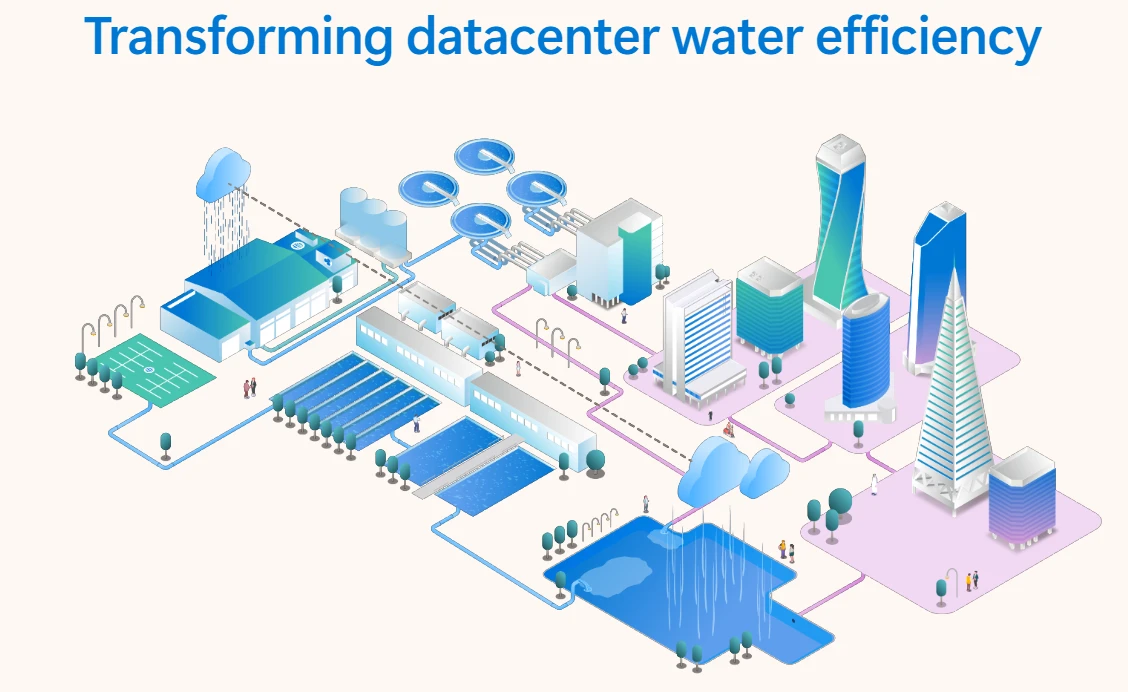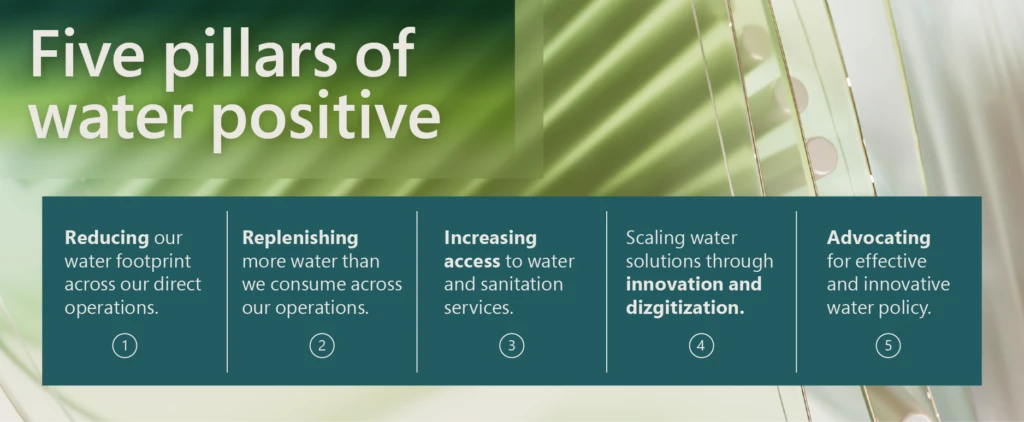
Learn more about how we’re making progress towards our sustainability commitments through the Sustainable by design blog series, starting with Sustainable by design: Advancing the sustainability of AI.
Last month, we unveiled our Datacenter Community Pledge, emphasizing that datacenters are not only the backbone of modern technology but also a force for good in the communities they serve. As part of this commitment, at Microsoft we recognize our crucial role in protecting and replenishing freshwater resources both in the regions where we operate and around the world.
That’s why in our datacenter operations, one of the essential engineering questions we ask each day is: how can we continue to conserve water while meeting growing customer demand for cloud and AI innovation?
In datacenters, water is primarily used for cooling and humidification. As demand for high performance cloud and AI applications has grown over the past few years to fuel customer applications and enable a new frontier of discovery and innovation, so have the power requirements for silicon chips—the basic building blocks of cloud and AI computing—that sit within the racks and servers of datacenters. Because advanced chips typically utilize more power, they also generate more heat. To prevent the chips from malfunctioning, more intensive cooling is needed, and this has historically required consuming water.
To reduce the water required for operations, a critical path to our company goal of becoming water positive by 2030, we’re innovating everywhere from our datacenter buildings all the way to the chips. Collectively, this work is delivering substantial results. From our first generation of owned datacenters in the early 2000s to our current generation in 2023, we have reduced our water intensity (water consumed per kilowatt-hour) by over 80%. This shows that it’s possible to significantly reduce how much water our datacenters use per kilowatt of power even as our cloud infrastructure expands.
Today, we are sharing more about two focus areas for continuing to drive down water intensity: (1) conserving water at every stage of operations, and (2) innovative technologies that reduce the amount of water needed for cooling.
Conserving water at every stage of operations
At all locations, we work to minimize the amount of water we require for cooling. This includes operating our datacenters at a temperature that allows us to cool with outdoor air the majority of the year, reducing the need for ambient cooling, and conserving water at every stage of day-to-day operations.

We conduct regular audits of our datacenters to identify inefficiencies and areas where design and day-to-day use don’t align. Our 2022 audit resulted in targeted improvements that eliminated 90% of the instances in which excess water was used. In addition, we’re building advanced prediction models that help us anticipate water requirements based on real-time weather and operational data. Comparing anticipated needs to actual consumption patterns enables us to quickly identify inefficiencies, such as water leaks that may otherwise go unnoticed.
To minimize freshwater requirements from municipal water systems, we employ conservation strategies that are tailored to the bioregion of the datacenters. For example, in Texas, Washington, California, and Singapore we’ve expanded our use of reclaimed and recycled water. In the Netherlands, Ireland, and Sweden we’re harvesting rainwater, and we’re also bringing this capability to new datacenters in Canada, the United Kingdom, Finland, Italy, South Africa, and Austria.
Innovative technologies that reduce the water needed for cooling
Innovative cooling technologies are essential to Microsoft’s water strategy, and we are rapidly expanding proven solutions across our datacenter portfolio. This includes solutions that bring cooling directly to the source of heat generation—the chip itself.
Cold plates are a prime example of this: a direct-to-chip cooling technology that provides heat exchange in a closed loop system. Cold plates dissipate heat more effectively than traditional air cooling, directly chilling the silicon and then recirculating the cooling fluid, like a car radiator. This solution significantly improves cooling efficiency and enables more precise temperature control compared to traditional methods.
To harness the increased efficiency cold plates offer, we’re developing a new generation of datacenter designs optimized for direct-to-chip cooling, which requires reinventing the layout of servers and racks to accommodate new methods of thermal management as well as power management. In existing datacenters, we’re also using innovations like the ‘sidekick,’ a liquid cooling system we’re already using adjacent to racks of Microsoft Azure Maia AI Accelerator chips, circulating fluid to draw heat away from the cold plates attached to the surface of the chips.
We’re also evolving cold plate technologies through our work with microfluidics, a technology that brings cooling inside the silicon by integrating tiny fluid channels into chip designs. Embedding the liquid cooling inside the chip brings the coolant right next to the processors, resulting in even more efficiency and precision.
Our newest datacenter designs are optimized to support AI workloads and consume zero water for cooling. To achieve this, we’re transitioning to chip-level cooling solutions, providing precise temperature cooling only where it’s needed and without requiring evaporation. With these innovations, we can significantly reduce water consumption while supporting higher rack capacity, enabling more compute power per square foot within our datacenters.
Reducing global water use through partnership, investing to replenish water
Our water positive goal guides us to consider not only how we can shift our business practices to reduce our water footprint but also how this work can benefit customers and partners working toward similar goals. The five pillars of water positive: reduction, replenishment, access, innovation, and policy all play important roles in our water positive journey.

Over the past year, we grew our water replenishment program significantly, nearly doubling our water replenishment portfolio to include more than 49 replenishment projects around the world. Together, these have the potential to replenish more than 24,000 Olympic size swimming pools over the lifetime of the projects. We also met our 2030 water access target to provide 1.5 million people with access to clean water and sanitation services.2
In addition, we’re working to reduce global water use by collaborating with customers, partners, local communities and municipalities to advance water infrastructure and policy around the globe. Because corporate approaches to water management generally lag investments in carbon reduction1, we’re taking an active role in championing effective and innovative water management practices and water policies. Some of our advocacy projects include: (1) serving on a coalition to increase water reuse and recycling across the United States, (2) funding projects that support Tribal Nations and state governments in increasing water security, and (3) supporting research, analysis, and advocacy on water in the European Commission.
Learn more about how Microsoft is advancing sustainability
Learn more about how we’re advancing sustainability through our Sustainable by design blog series, starting with Sustainable by design: Advancing the sustainability of AI. For more information on our progress towards our sustainability goals, read the Microsoft 2024 Environmental Sustainability Report.
1Why investment in water is crucial to tackling the climate crisis, World Economic Forum, 2024.
22024 Environmental Sustainability Report, Microsoft.